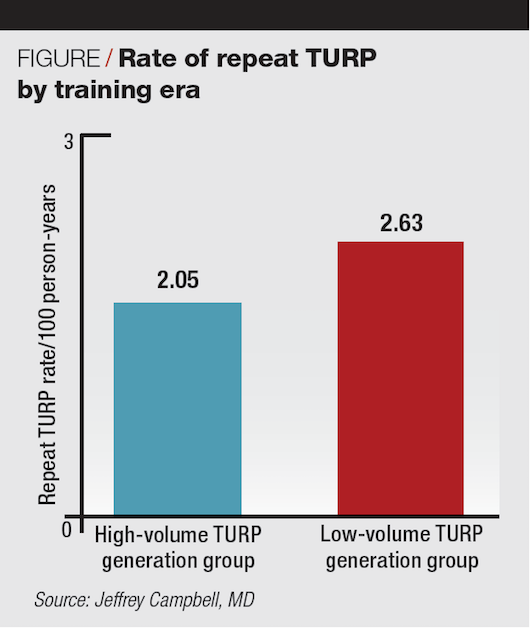Article
Training era linked to TURP outcomes
Author(s):
Men who undergo transurethral resection of the prostate are more likely to need a repeat procedure if their urologist graduated medical school after 1995 rather than earlier, according to findings of a retrospective population-based cohort study.
megaflopp - stock.adobe.com

Men who undergo transurethral resection of the prostate (TURP) are more likely to need a repeat procedure if their urologist graduated medical school after 1995 rather than earlier, according to findings of a retrospective population-based cohort study.
The explanation for the finding may be that compared to their older colleagues, the more recently trained urologists had less exposure to TURP during residency, said Jeffrey Campbell, MD, at the AUA annual meeting in Chicago.
Also see: Panel crafts recommendations for cath management following BPH surgery
“TURP is an important procedure that remains the gold-standard treatment for BPH. It can be challenging to learn because it is an endoscopic procedure, and attaining true proficiency requires significant practice. With the growth of medical management of BPH, however, urology residents are having less opportunity to perform TURP during their training,” Dr. Campbell said.

“We believe that it is important to be cognizant of this situation and its potential to impact patient outcomes and then to consider goals for simulated training and strategies that would allow residents to do more TURP procedures. Furthermore, the findings of our study raise the question of whether outcomes of other urologic procedures are being affected by urologists’ training era.”
Dr. Campbell was involved in the study as a urology fellow, Western University, London, ON. He is now assistant professor of surgery (urology) at Western University.
The authors used two provincial data sources-the Canadian Institute for Health Information Discharge Abstract Database and Same Day Surgery and the Ontario Health Insurance Plan-to identify men in Ontario, Canada who were older than 40 years of age and had a first TURP between 2003 and 2016 in Ontario. A total of 78,176 men fit the inclusion criteria, and they were operated on by 314 different surgeons.
The patients were divided into two groups defined as the “high-volume TURP generation” (63,223 men) and “low-volume TURP generation” (14,953 men) based on whether the urologists who performed their primary TURP graduated from medical school before or after 1995, respectively.
Next: Post-1995 graduates performed fewer TURPsPost-1995 graduates performed fewer TURPs
Surgeons graduating after 1995 had done significantly fewer TURPs during the previous 5 years compared with their senior colleagues (median, 172 vs. 402; p<.001). A significantly higher proportion of TURP procedures were done with a laser-based modality in the low-volume TURP generation group than in the high-volume TURP generation (17.8% vs. 10.6%; p<.01).
As a primary outcome measure, the study evaluated the need for a repeat TURP more than 14 days after the primary procedure. After a median follow-up of 5 years, the repeat TURP rate/100 person-years was 2.05 for patients in the high-volume TURP generation group and 2.63 in the low-volume TURP generation patients. In an adjusted marginal Cox regression model accounting for covariates, the odds of having a reoperation was 1.2-fold higher for men in the low-volume TURP generation group than for those in the high-volume TURP generation group.
Read: Data from 18-year study support HoLEP’s efficacy
“One explanation for the difference may be that men who undergo TURP in the medical management era wait longer before they have surgery and therefore have larger prostates. Although our databases do not capture information that would allow us to explore this hypothesis, we expect that prostate size at the time of TURP would be similar in the two patient cohorts because all of the patients were from the medical management era even though the surgeons trained in different eras,” said Dr. Campbell.
Looking at other differences between the two cohorts, the study found that compared with the high-volume TURP generation group, men in the low-volume TURP generation group were significantly more likely to have an emergency department visit but significantly less likely to have received a blood transfusion.
“The difference in emergency department visits might also be an indicator of a less successful TURP in the low-volume TURP generation group. A possible explanation for the difference in blood transfusion rates may be that the low-volume TURP generation surgeons had a lower threshold for ordering a blood transfusion than their senior colleagues,” Dr. Campbell said.
















